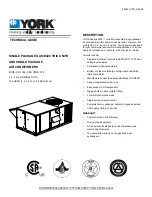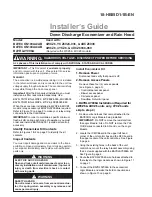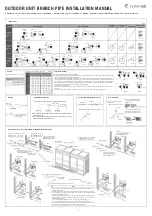
IM 812 / Page 15 of 28
Heater
Unit
Plug Size
Unit Fuse
kW
Voltage
(amps)
or Breaker
Available on Units
(amps)
2.0
208
15
15
07 & 09 - AC & HP
2.4
230
15
15
07 & 09 - AC & HP
2.4
265
20
15
09 - HP
2.9
208
20
20
07, 09, 12, 15 - AC & HP
3.6
230
20
20
07, 09, 12, 15 - AC & HP
3.6
265
20
20
07, 09, 12, 15 - AC & HP
Initial start-up of the unit by trained, experienced personnel, is
usually the responsibility of the installing contractor. This start-
up consists of inspecting and operating the equipment for all
functions at the time of initial installation, and making neces-
sary adjustments. It also includes demonstrating its proper
operation to the owner or the owners’ agent. Note that, unless
otherwise specifically agreed to in writing, the manufacturer
includes no field labor, start-up service or the like in the price
of its equipment. After the equipment leaves the factory, it
may become damaged or maladjusted during transportation
or on the job. Sometimes wires are disconnected acciden-
tally, or fan motors move on their bases due to rough han-
dling, causing fans to strike. Correcting such conditions is part
of start-up. Confirm that all dip switch settings are OFF ex-
cept #8 of 8 and #3 of 4. Obtain the owners written authoriza-
tion for any other settings. Any dip switch change must be
activated by unplugging and plugging in the power cord.
Note: Freeze protection (#4 of 4) must be in the OFF posi-
tion (see page 4).
Note: There are various time delays built into the system
when using the unit or wall mounted control pad. Most of
these delays are only for a few seconds, but they can be
up to four minutes. The compressor will delay for two min-
utes before it can be restarted on both the control pad
and remote thermostat. The compressor will run for 90
seconds minimum unless the mode is changed. The fan
runs for 15 seconds after the electric heater turns off. The
unit will always start up with random time delay.
1.
Chassis (size 12 & 15 only) with a separate field installed
power cord, have a universal electric heater. The field in-
stalled power cord selected determines the Kw output.
Make sure you have the right cord for the heater Kw re-
quired by the owner. See Table 2 below. See table 3 for
availability of units with factory installed cords.
Equipment Start-up
2.
Make certain the chassis power cord is plugged into a
receptacle with the correct voltage and fuse protection as
required by the unit data plate. See IM 714 (ships with the
power cord) for more detail about the field installed power
cord and receptacle. Coil up any excess cord length and
stow it under the control box.
3.
Open or close the ventilation damper door as required by
the owner. The actuator is located at the lower left end of
the chassis. See Figure 15.
Note: Remove shipping screw from door if it needs to be
opened.
4.
If the conditioner will use the standard control pad,
continue to step 5. If a remote thermostat will be used
rather than the control pad, skip over steps 5 through 18
and continue with step 19.
5.
If the control pad is being remote mounted, mount it on
the wall. Be sure to plug in the 6 wire cable that connects
it to the unit mounted control box. Snap on the decorative
cover at the unit. See pages 4 and 8 for more information.
If the control pad is not wall mounted, plug it in and attach
it to the chassis using the two hooks located on the top of
the control box.
Note: If upon initial power up, the digital temperature dis-
play reads between 16
o
and 30
o
(Celsius), unplug the power
cord and plug it back in again to reset for Fahrenheit (60-
85
o
).
6.
Test HEAT by selecting the heat mode and increasing the
temperature setting until the unit is discharging heated air.
Note: Initial electric heater activation may result in slight
burning odor. Run the heater at time of installation sev-
eral minutes until any odor dissipates. To activate electric
heaters on heat pump models, select a unit temperature
several degrees above room temperature.
7.
Test COOL by selecting the cooling mode and decreasing
the temperature setting until the discharge air is cold.
8.
Test FAN by selecting the fan mode and increasing the
temperature setting to 85
o
F. There should be no heat.
Lower the setting to 60
o
F. There should be no cooling.
9.
Test COOL/DRY by selecting the COOL mode. With indi-
cator light in COOL, press and hold the Mode key for 15
seconds until light switches to COOL/DRY. Then decrease
the temperature setting until the discharge air is cold.
Switch back to COOL by again pressing the Mode key for
15 seconds.
10. Test fan speed AUTO/HIGH/LOW as follows: With the unit
in either HEAT, or COOL mode, switch back and forth be-
tween AUTO, HIGH and LOW speed, using the FAN key
on the control pad. The sound level between HIGH and
LOW will be noticeable and shown by indicator light. AUTO
gives Low fan if temperature setting is within 2
o
F of room
temperature and High fan if more than 2
o
F from room tem-
perature.
Table 2. Field Installed Power Cords
(2)
Heater
Unit
Vendor
Plug Size
Unit Fuse
kW
Voltage
Number
(3)
(amps)
or Breaker
Size (amps)
0
(1)
208
105575512
15
15
0
(1)
230
105575512
15
15
0
(1)
265
105575804
20
15
2.0
208
300040734
15
15
2.4
230
300040734
15
15
2.4
265
300040737
20
15
2.9
208
300040735
20
20
3.6
230
300040735
20
20
3.6
265
300040738
20
20
4.1
(2)
208
300040736
30
25
5.1
(2)
230
300040736
30
30
5.1
(2)
265
300040739
20
(4)
25
(1)
Cooling Only
(2)
Unit Size 12 and 15 only
(3)
Molded on power cord receptacle
(4)
If an existing receptacle is 30 amps, use power cord #300040740 (30 amp plug)
Table 3. Factory Installed Power Cords














































